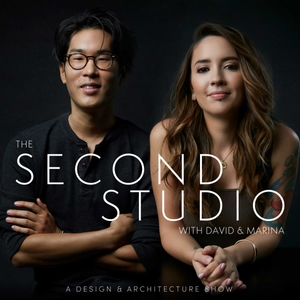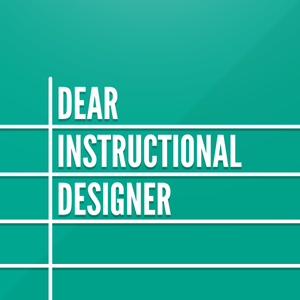
Design Guy, Episode 7, Designer's Attributes Pt. 1
09/17/07 • -1 min
Design Guy here, welcome to the show. This is the program that explores timeless principles of design and explains them simply.
If you're just joining us, we're talking about the attributes of the designer. In the last episode, we established the idea that, as designers, we profoundly influence the work we do by the mere fact of who we are as individuals. Our unique way of thinking and solving problems, our personal style and perspective on the world, all have an impact on the product. Our fingerprints are all over our work, so to speak. You can I.D. a designer through their work sometimes. And this is obviously why certain designers are sought after. We tend to describe their work as unique or distinctive. So, it stands to reason that if we give one design problem to two different designers, we can expect somewhat different outcomes.
At the same time, though, there are certains traits that designers should have in common. Unique as we all are, there are certain stereotypes or generalizations that ought to hold up in order for graphic designers to qualify as graphic designers.
If your into movies, you'll know how it is to hear that a certain director is rumored to be helming a film project. When we hear the name Tim Burton or Steven Soderbergh or Guillermo Del Toro, we develop different expectations. At the same time, we're pretty confident that while they think divergently, and that they'll all emphasize different themes, that they've got some other things in common. They all know a thing or two about storytelling, and casting, and where to put the camera.
That's how it is with designers. Unique as we are, some things are the same.
So, in no particular order, I'd like to describe the traits we can expect.
And I'll just mention the first one today, which is this. A designer takes an interest in the world around them.
Adrian Shaughnessy, in his book, How to be a graphic designer without losing your soul, (1)writes: "Among the myriad definitions of graphic design, one of the most illuminating is by American designer and writer Jessica Helfand. According to Helfand, graphic design is a visual language uniting harmony and balance, color and light, scale and tension, form and content. But it is also an idiomatic language, a langauge of cues and puns and symbols and allusions, of cultural references and perceptual inferences that challenge both the intellect and the eye."
Commenting further on Helfand's definition, Shaugnessy says, "I like Helfand's definition. Her first sentence is a conventional summary of graphic design; few would argue with it. But the second part of Helfand's definition provides the key to producing meaningful and expressive graphic design, (when she refers to): 'cues and puns and symbols and allusions, of cultural references and perceptual inferences.' (These) are the elements that give work authority and resonance. And if you want to introduce these elements into your work, it means taking a interest in everything that goes on around you, and having curiosity about areas other than graphic design: politics, entertainment, business, technology, art, ten-pin bowling and mud wrestling.
This cultural awareness ranks higher than technical ability and academic qualifications in the designer's portfolio of attributes." (End of quotation)
James N. Frey, (2) author of How to Write a Damn Good Novel, expresses the same sentiment in writing the following:
"You''ll need to be a general reader, because you need to know, well, a lot of stuff. (Be) a well read generalist, as opposed to a specialist, like a chiropractor or plumber or teacher. How can you create a Buddhist character if you don't know what meditation is for? How can you create a carpenter if you don't know what a T square and a level are for? A fiction writer needs a grasp of history and philosophy, art, religion, poetry, and so on, in order to understand different viewpoints and world views, to make his or her characters whole." (End of quotation)
Think of it this way, think in just general social terms. People who are well read and aware of many things can relate to more people. If you're an engineer and all you can talk about is engineering, you can't connect effectively to another person. But if you can talk about the news or fishing or the latest of episode of Heroes, in addition to engineering, then you build a more robust bridge to the other person. As graphic designers we want to tap into the culture or zeitgeist or ethos, as I mentioned last time, so we can be more effective. So start broadening your horizons. Watch TV shows you formerly shunned. If you read Rolling Stone, try reading McCalls. You'll be amazed at what you can bring into your world from someone else's.
And that's it for today. As usual, I'll post show notes at my webpage, which is designguyshow.blogspot.com. Music is b...
Design Guy here, welcome to the show. This is the program that explores timeless principles of design and explains them simply.
If you're just joining us, we're talking about the attributes of the designer. In the last episode, we established the idea that, as designers, we profoundly influence the work we do by the mere fact of who we are as individuals. Our unique way of thinking and solving problems, our personal style and perspective on the world, all have an impact on the product. Our fingerprints are all over our work, so to speak. You can I.D. a designer through their work sometimes. And this is obviously why certain designers are sought after. We tend to describe their work as unique or distinctive. So, it stands to reason that if we give one design problem to two different designers, we can expect somewhat different outcomes.
At the same time, though, there are certains traits that designers should have in common. Unique as we all are, there are certain stereotypes or generalizations that ought to hold up in order for graphic designers to qualify as graphic designers.
If your into movies, you'll know how it is to hear that a certain director is rumored to be helming a film project. When we hear the name Tim Burton or Steven Soderbergh or Guillermo Del Toro, we develop different expectations. At the same time, we're pretty confident that while they think divergently, and that they'll all emphasize different themes, that they've got some other things in common. They all know a thing or two about storytelling, and casting, and where to put the camera.
That's how it is with designers. Unique as we are, some things are the same.
So, in no particular order, I'd like to describe the traits we can expect.
And I'll just mention the first one today, which is this. A designer takes an interest in the world around them.
Adrian Shaughnessy, in his book, How to be a graphic designer without losing your soul, (1)writes: "Among the myriad definitions of graphic design, one of the most illuminating is by American designer and writer Jessica Helfand. According to Helfand, graphic design is a visual language uniting harmony and balance, color and light, scale and tension, form and content. But it is also an idiomatic language, a langauge of cues and puns and symbols and allusions, of cultural references and perceptual inferences that challenge both the intellect and the eye."
Commenting further on Helfand's definition, Shaugnessy says, "I like Helfand's definition. Her first sentence is a conventional summary of graphic design; few would argue with it. But the second part of Helfand's definition provides the key to producing meaningful and expressive graphic design, (when she refers to): 'cues and puns and symbols and allusions, of cultural references and perceptual inferences.' (These) are the elements that give work authority and resonance. And if you want to introduce these elements into your work, it means taking a interest in everything that goes on around you, and having curiosity about areas other than graphic design: politics, entertainment, business, technology, art, ten-pin bowling and mud wrestling.
This cultural awareness ranks higher than technical ability and academic qualifications in the designer's portfolio of attributes." (End of quotation)
James N. Frey, (2) author of How to Write a Damn Good Novel, expresses the same sentiment in writing the following:
"You''ll need to be a general reader, because you need to know, well, a lot of stuff. (Be) a well read generalist, as opposed to a specialist, like a chiropractor or plumber or teacher. How can you create a Buddhist character if you don't know what meditation is for? How can you create a carpenter if you don't know what a T square and a level are for? A fiction writer needs a grasp of history and philosophy, art, religion, poetry, and so on, in order to understand different viewpoints and world views, to make his or her characters whole." (End of quotation)
Think of it this way, think in just general social terms. People who are well read and aware of many things can relate to more people. If you're an engineer and all you can talk about is engineering, you can't connect effectively to another person. But if you can talk about the news or fishing or the latest of episode of Heroes, in addition to engineering, then you build a more robust bridge to the other person. As graphic designers we want to tap into the culture or zeitgeist or ethos, as I mentioned last time, so we can be more effective. So start broadening your horizons. Watch TV shows you formerly shunned. If you read Rolling Stone, try reading McCalls. You'll be amazed at what you can bring into your world from someone else's.
And that's it for today. As usual, I'll post show notes at my webpage, which is designguyshow.blogspot.com. Music is b...
Previous Episode

Design Guy, Episode 6, Harry Houdini and the Attributes of a Designer
Download Episode 6
Design Guy here, welcome to the show.
This is the program that explores timeless principles of design and explains them simply.
If you've been following along, you'll know that we've been talking about the very beginning stages of the design process, and the skills we need to develop in order to gather the information that fuels our creative work.
So, moving right along, there are some practical process things we could talk about next, like brainstorming and how to get ideas, but before we do that, I think this is a good time for us to pause and consider the designer in all of this.
If we think about it, the designer is the first medium through which ideas pass. Before we choose a physical format or medium, we're it. And I realize this is a really obvious statement. But if "the medium is the message," as Marshall McLuhan(1) famously declared, then I think it's worth stepping outside ourselves for a moment, to consider what kind of medium we are. What kind of attributes should we have as designers before we even get started on the work?
Let's consider the word medium for a moment. When we say something is immediate, it means there's nothing inbetween, there's a direct connection between two things. But when there's a medium, we mean to say that there's something inbetween, something that intervenes. Designers intervene. We take one thing, and pass it through the medium of ourselves, so it becomes a somewhat different thing. We're like prisms that receive the light and then refract it. We take our client's message and then split it apart, we break it all down. We perform a reductive work so we can identify the component parts. Then we build it back up again in just the right way, and communicate it. We basically perform a work of translation. We take ordinary language and convert it into visual language.
Medium is also the word used to describe individuals who claim to have psychic ability. People who claim to be conduits or channels to another world. I find this interesting because we're applying the word medium to an actual person.
If you've ever seen the old Tony Curtis film, Houdini,(2) you'll remember that he and his wife were obsessed with life after death. They made a pact that they would seek to make contact with each other if one should pass on to "the other side." So you may remember the scene where she visits a psychic medium, who conducts a seance. They're all in a dimly lit room. There was the typical mumbo jumbo and theatrics staged to convince Mrs. Houdini that she was communing with Harry himself. But, alas, this medium was a charlatin attempting to cash in on the poor widow's grief-driven compulsion to make contact. The point here, though, is that Mrs. Houdini was in search of a medium. She wanted to find a person who could bridge a gap that she could not cross by herself.
Our clients are like this. They look to us as channels or mediums to their marketplace, where they hope to connect with an audience. They can't cross this gulf all by themselves. They know that they need someone with special attributes. They need someone with specialized communication skills, who can send their message across in just the right way. And if we're really on our game, we might be able to channel ghosts of a different kind. I'm being a little bit cute here. But I'm referring to what's sometimes called the zeitgeist, or spirit of the age. Which is to say that wherever we can , we want to inform our work with a keen sense of the cultural context or our audience—their world, their ethos.
Now, in light of everything we've said, we can see why certain designers are sought after. They've got certain attributes that the client is looking for. They want these attributes to show through the final product.
We see this principle at work when we're evaluating a design piece. If we describe it as witty or traditional or sophisticated or minimalistic, then we're describing the designer to a great extent. These characteristics mirror the person behind the work. And if you give the same design problem to two different designers, you'll get two different results. They may both be valid, and indeed one design problem can be solved a thousand different ways. But, I believe there are certain characteristics that all designers ought to share in common. There are some common attributes that will show through in the work of even the most wildly divergent designers. And we'll talk about what some of those attributes are in the next episode.
For now, let's just establish that the designer is like the physical format we'll select to do our work within, because we profoundly influence the work. And, again, this is a really obvious statement. But, if we want our attributes to reflect well on the work, we'll give some consideration to ourselves. We'll want to make sure we've got c...
Next Episode

Design Guy, Episode 8, Designer's Attributes Pt. 2
Download Episode 8
Design Guy here, welcome to the show. This is the program that explores timeless principles of design and explains them simply.
We're talking about the attributes of the designer. And we began last time by asserting that graphic designers take an interest in the world around them. We said that it's preferable to be a generalist, rather than a specialist. And what we mean to say in this is that it's not a good thing to know your profession to the exclusion of other things. You want to cultivate a curiosity in many things. To that end, you should read widely and expose yourself to new things whenever you can. If you're musical tastes run toward the Smashing Pumpkins, go see an opera. You get the picture. The idea here is that we're supposed to help our clients make a connection with their audience. So, the more informed we are to the world of the client, the more effective we'll be at bridging that gap. In order to do this well, we want to be good at the next attribute. And that's COMMUNICATION.
Robin Landa, in her book Graphic Design Solutions, writes, Graphic designers use words (type), and pictures and other graphic elements (visuals) to communicate. Their art is a visual-verbal expression. The graphic designer mediates between a client with a message to send and the audience. Visuals and words are used by the designer on behalf of the client in order to inform, persuade, or sell." (end of quotation)
And that's a basic definition of graphic design. Visual communication. And as we get deeper into this podcast series we'll tackle all the various elements and principles of design that foster that visual form of communication. So, there's really not much more to say about this right now. To become a better visual communicator, you need to study this craft of graphic design. By learning about contrast or proportion, for example, you communications will improve visually.
Now, although it's obvious, I should point out that this visual communication that we call graphic design is all written and visual. There are no spoken words. But the verbal, spoken form of communication is also a skill that we've got to get better at. It's our verbal skill that will persuade a client to buy into our ideas and to hire us, it's our verbal skill that makes us more skillful at business, that persuade a client to pay us for services rendered. And, of course, the better we can exchange ideas between ourselves as team members on projects, the better our resulting graphic design will be, as we sharpen up our collective vision for the product.
Adrian Shaugnessy in his book, How to be a Graphic Designer Without Losing Your Soul, writes, "The way designers present ideas is as important as the ideas themselves. When a good idea is being rejected, it is often the presentation of that idea that is being rejected, and not the idea itself....Spoken communication therefore is a vital component of the modern designer's kitbag. But there is a communication skill even more important than being able to talk convincingly about your work: listening. I'm talking about the acknowledgement that communication is a two-way street, and that your client has a point of view that you need to listen to carefully for clues and unspoken messages." (end of quotation)
Now, if you've been listening to earlier episodes, you'll be experiencing deja vu about now, because we spoke pointedly to the necessity of listening. If you've missed those shows, you can go back and review them, of course.
But I think we'll wrap things up here. And we'll summarize by saying that if the first attribute, which is an interest in the world around us, can be likened to input, then communication (both the visual and verbal kind) is the output. So, we need to recognize that they work together. Garbage in. Garbage out. Or diversified understanding of the world in, rich, layered communications out.
Well, I want to thank you again for listening. If you'd like to check out the show notes, you can find them at my web page, which is designguyshow.blogspot.com. Music is by Kcentricity.com. If you've been finding these shows helpful, I'd welcome your feedback in the form of a vote at podcast alley or perhaps a comment at iTunes. Until next time, this is Design Guy, hope you'll join us again.
References
1. Landa, Robin, Graphic Design Solutions, 2nd Ed., OnWord Press, 2000
2. Shaughnessy, Adrian, How To Be A Graphic Designer Without Losing Your Soul, Princeton Architectural Press, 2002Subscribe in iTunes - it's free!
If you like this episode you’ll love
Episode Comments
Generate a badge
Get a badge for your website that links back to this episode
<a href="https://goodpods.com/podcasts/design-guy-5145/design-guy-episode-7-designers-attributes-pt-1-197299"> <img src="https://storage.googleapis.com/goodpods-images-bucket/badges/generic-badge-1.svg" alt="listen to design guy, episode 7, designer's attributes pt. 1 on goodpods" style="width: 225px" /> </a>
Copy




